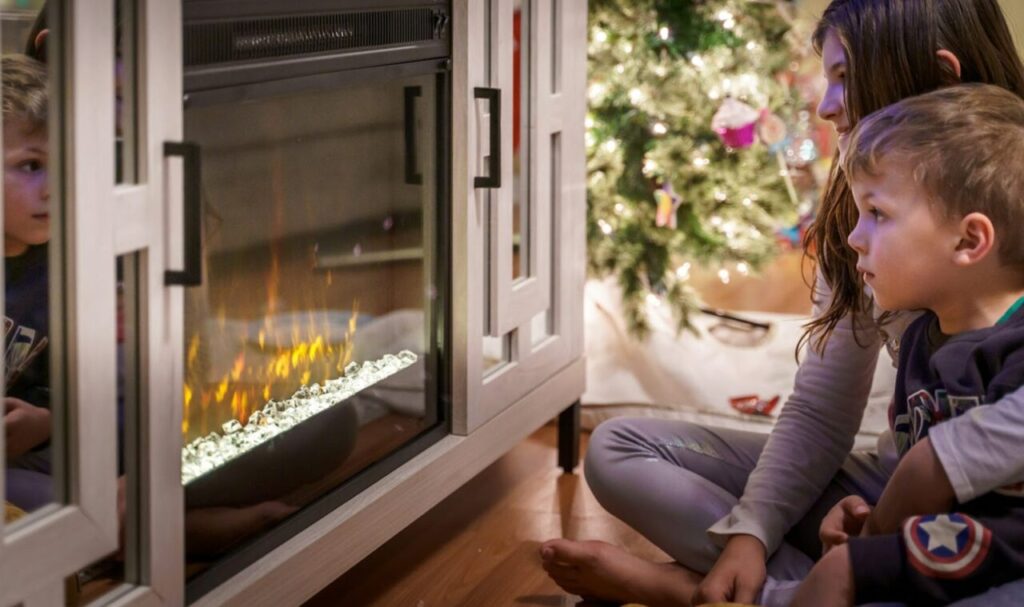As the leaves begin their annual transformation from lush green to brilliant oranges, yellows, and reds, it’s time to shift our focus to getting our homes ready for cooler months.
Fall maintenance isn’t just about making things look nice; it’s an investment in the safety, comfort, and lifespan of your home.
By taking proactive steps now, you can avoid winter repairs, keep your home energy-efficient, and enjoy a cozy season with fewer surprises.
So, let’s dive into a simple checklist to help you get started on the essentials!
1. Exterior Home Maintenance
Taking care of your home’s exterior in the fall can help to limit damages from harsh winter weather.
And the best place to start is with your roof.
A solid roof with no moisture issues is a huge win in the fall maintenance battle as it’s the first line of defense against winter weather.
Moisture damage
Check for damaged or missing shingles that could let in moisture. Look for signs of leaks, and clear off any debris that could lead to ice dams as temperatures drop.
Just these few things can help prevent costly repairs in the middle of winter.
Clean and Repair Gutters
Gutters often collect leaves and debris, leading to blockages that can cause water damage. It’s important to clear these clogs and inspect for any rust or sagging areas that may require attention.
When gutters become clogged and are not regularly cleared, they can quickly overflow, sending torrential water everywhere, including around your home’s foundation.
In addition, when conditions are right (or rather, wrong from your home’s perspective), the trapped water can freeze, forming ice.
This ice then weighs down the gutters, and adds stress to the entire system, potentially collapsing everything!
Check for and Seal Exterior Cracks
Check your home for cracks or gaps in the foundation, windows, and doors. Sealing these spaces helps keep warm air inside and cold air out.
This can lower your energy bills and make your home more comfortable. Use caulk around windows and add weather stripping to doors to improve energy efficiency.
Inspect Chimneys and Fireplaces
Got a fireplace?
Make it a priority to have your chimney inspected every fall. A thorough cleaning removes buildup and keeps out debris and animals. This ensures a safer and more enjoyable fire during chilly nights.
2. Interior Home Preparation
As temperatures drop, a few adjustments inside the home can make a big difference in comfort and safety.
Inspect and Replace HVAC Filters
Dirty filters cause your HVAC system to work harder, increasing energy bills and affecting air quality. Checking and replacing filters in the fall ensures proper airflow, saves energy, and keeps your home comfortable.
Test Smoke and Carbon Monoxide Detectors
Fall often means firing up heating systems, which makes it the perfect time to check your smoke and carbon monoxide detectors. Ensure all devices are working, and replace batteries if needed. This small step is key to keeping your home safe through the winter heating season.
Inspect Insulation in the Attic and Basement
Proper insulation helps retain heat and block out cold, which can reduce your heating costs. Check both your attic and basement for any areas where insulation may be thin or missing, as well as for drafts. Add insulation where needed to improve comfort and lower your energy bills.
3. Landscaping
Your outdoor space needs some prep to stay in top shape until spring.
Lawn Care and Leaf Removal
Raking leaves may seem like a chore, but it’s essential for the health of your lawn. If leftover leaves are not removed, they can create mold and harm the grass beneath them. After clearing the yard, consider applying a layer of fertilizer to strengthen the grass roots for spring growth.
Winterize Outdoor Faucets and Irrigation Systems
Frozen pipes can be a homeowner’s worst nightmare. To prevent this issue, make sure to disconnect and drain garden hoses, shut off outdoor faucets, and winterize any irrigation systems. If you live in an especially cold area, consider insulating outdoor water sources to help prevent freezing and bursting.
Prune Trees and Bushes
Trim back any branches that could break under heavy snow and damage your home. Focus on plants close to your house, especially those that benefit from fall pruning, such as deciduous shrubs and trees. This process not only helps protect your home but also promotes healthier growth in the spring.
4. Vehicle and Garage Preparation
As you prepare your home, be sure to also take care of your vehicle and garage.
Inspect Vehicles for Winter
Before the cold weather arrives, make sure to check your car’s tires, fluids, and battery to ensure everything is functioning properly.
If you live in an area that frequently experiences heavy snowfall, consider installing snow tires early. A well-prepared vehicle can significantly improve your safety and comfort during challenging winter driving conditions.
Organize and Store Summer Equipment
With the gardening season coming to an end, store items like lawnmowers and patio furniture properly to prevent rust and weathering. This keeps your equipment in good shape for next spring, helping you avoid unnecessary replacement costs.
Ensure that shovels, snow blowers, and salt are accessible before the first snowfall. Testing your equipment now will prevent you from scrambling to make repairs in freezing weather. A few minutes of preparation can save you a lot of hassle when the first snowstorm arrives.
5. Energy Efficiency Tips for Colder Months
Small steps can add up to big savings on your heating bill.
Seal Drafty Windows and Doors
If you notice any drafts, try adding weather stripping or caulking where needed. Sealing these gaps keeps warm air in and can cut down on heating costs. It’s a quick fix with a big payoff.
Use Programmable or Smart Thermostats
A programmable thermostat allows you to adjust your home’s temperature according to your schedule, leading to significant energy savings. Set lower temperatures during the night or when you’re away to save on heating while maintaining comfort.
Make the Most of Natural Light and Ventilation
Open curtains during the day to let in natural light and heat from the sun. This adds warmth and brightness while reducing the need for artificial heating. Proper ventilation also prevents moisture buildup, which is essential for maintaining a cozy, healthy home.
Fall maintenance may seem like a lot, but each task is a simple way to prepare for a safe and cozy winter. By following this checklist, you’re not only protecting your home but also creating a more comfortable space for yourself and your family. Start with a few steps each weekend and consider professional inspections where necessary. Here’s to a warm, worry-free season ahead!
10 Fall Home Maintenance Tasks Every Homeowner Should Do








